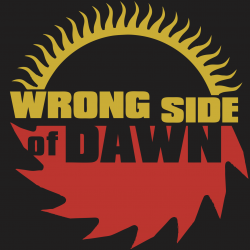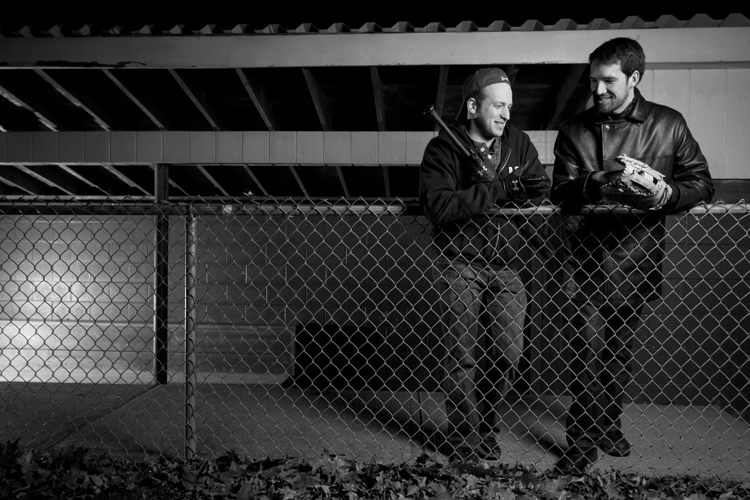It’s here! Just in time for the finish of the Major League pennant race, Wrong Side of Dawn has released the “Baseball” music video! But the video isn’t directed at World Series champions. This one is for the rest of us.
WRITING “BASEBALL”
“Baseball” is actually partly the musical daughter of “The Grinder’s Tale” (another song about the effort to make a living by playing a game). It’s origins are in this Music Theory 101 project that I wrote at age 18 (please excuse my amateurish violin-playing on the melody–the composition is good, but the execution is not). I’d recently written the guitar riff that would become “The Grinder’s Tale.” It was one of the few riffs of mine that I really liked. When my music theory class was given the assignment to finish the semester by writing a classical composition, my goal was to create a classical piece based off of my favorite original riff.
You’ll notice the similarities to “The Grinder’s Tale” in the opening motif. But as classical pieces often do, I let the melodies and harmonies venture off into other places. In particular, I latched onto the little transition back to minor that you hear at 2:04 to 2:07.
So I decided to reverse the process I’d used to write this song, and create a rock version of that classical section! The melodies and chords that you hear in the “Baseball” bridge riff (2:31 to 2:51 of the music video) are based off that portion of my music theory project. The chords became the song’s chorus.
The opening riff was something I thought of mentally while in the shower. Based around an F# octave, I harmonized it with 2 otherwise-unrelated chords that both contain F# (D major-add9, and B7).
Because of the lineage from “The Grinder’s Tale,” I initially intended to write a song called “The Grinder’s Tale Part 2,” and use this as its musical base. However, I eventually decided that the world has enough poker songs for now. Besides, despite being one of the best, and definitely the most heavily-promoted, song from Stay Awake, “The Grinder’s Tale” and its poker theme didn’t exactly vault us into Miley Cyrus-level stardom. So maybe it was time for a new direction.
The lyrics stem from a conversation I had with my brother in my parents’ garage. We were commenting on the amount of boys who dream of being professional athletes, compared with the microscopic percentage that actually make it to the highest professional league. I observed, “Almost every man in America is some boy who failed to make it as a professional athlete. We all have that in common.” In the song, this became shortened to: “Every man is just a boy who never made it in baseball.” And that’s where the lyrics began.
“BASEBALL,” THE VIDEO
The “Baseball” music video was filmed and directed by Adam Chinoy, the man behind our “Crossing the Bar” video. But while “Crossing the Bar” was shot in a single morning, “Baseball” was a more ambitious project.
The “live” footage of the band was actually taken on two separate nights. Any close-ups of the band were filmed on the Tuesday before the “Baseball/If I Ever Loved” release show. The wide shots (where you can see the audience) were filmed at the show itself, on Friday. It was a simple trick to create the illusion that all the footage is from a single live performance… All we had to do was wear the same clothes both nights.
From there, we went into several rounds of “this needs something more.” For a song about baseball, the live performance footage was lacking in, well, baseball. To fix this, I talked to a family that I coach swimming with. In addition to swimming, their son also plays baseball. So we asked if we could attend one of his games and get some Little League baseball footage. Andrew, our child star, had the additional advantage of bearing certain physical similarities to me (mainly, he’s a white guy with blond hair). This allows the video to be interpreted as us playing essentially the same person. He’s the Little League ballplayer with the potential to make the majors. I’m the adult former ballplayer who never actually got there.
Nelson, Adam and I arrived early to film the batting practice scene you see at the end of the video. And while I insist that I can hit a ball over a 305-foot fence, I’ll admit that the ball you see me hit in the video didn’t actually travel that far. My “near-miss home run” was actually tossed against the wall by hand.
(Some time had passed since our initial performance footage, and that time included a haircut for me! You’ll notice that what’s hiding under my Yankee cap doesn’t exactly match what you see on the stage portion.)
Finally, we decided to add a little bit of a narrative element to the video, via the text portions shown during the instrumental sections. Told through statistics, it’s meant to underscore the essential theme of the song: big dreams are available to everyone, but only a few people fully achieve them. And most of us manage to build a decent life despite the fact that we fall short of greatness.
(Some people have asked about the exclusive focus on “American” baseball players. There are two reasons for this. The first is statistical consistency. We combined an estimate of how many American boys begin playing baseball each year with how many new Major League careers are created every year. If we started with Americans, we must end with Americans, and that requires an acknowledgement that men from other countries are competing for the same finite number of jobs. Also, in a song that mentions “American dreams” in the chorus, we wanted to keep the focus on the “American” element of its theme: the idea that an ordinary American boy can grow up to become rich by playing “America’s pastime.”)
Anyway, without further delay, go check out the video!


